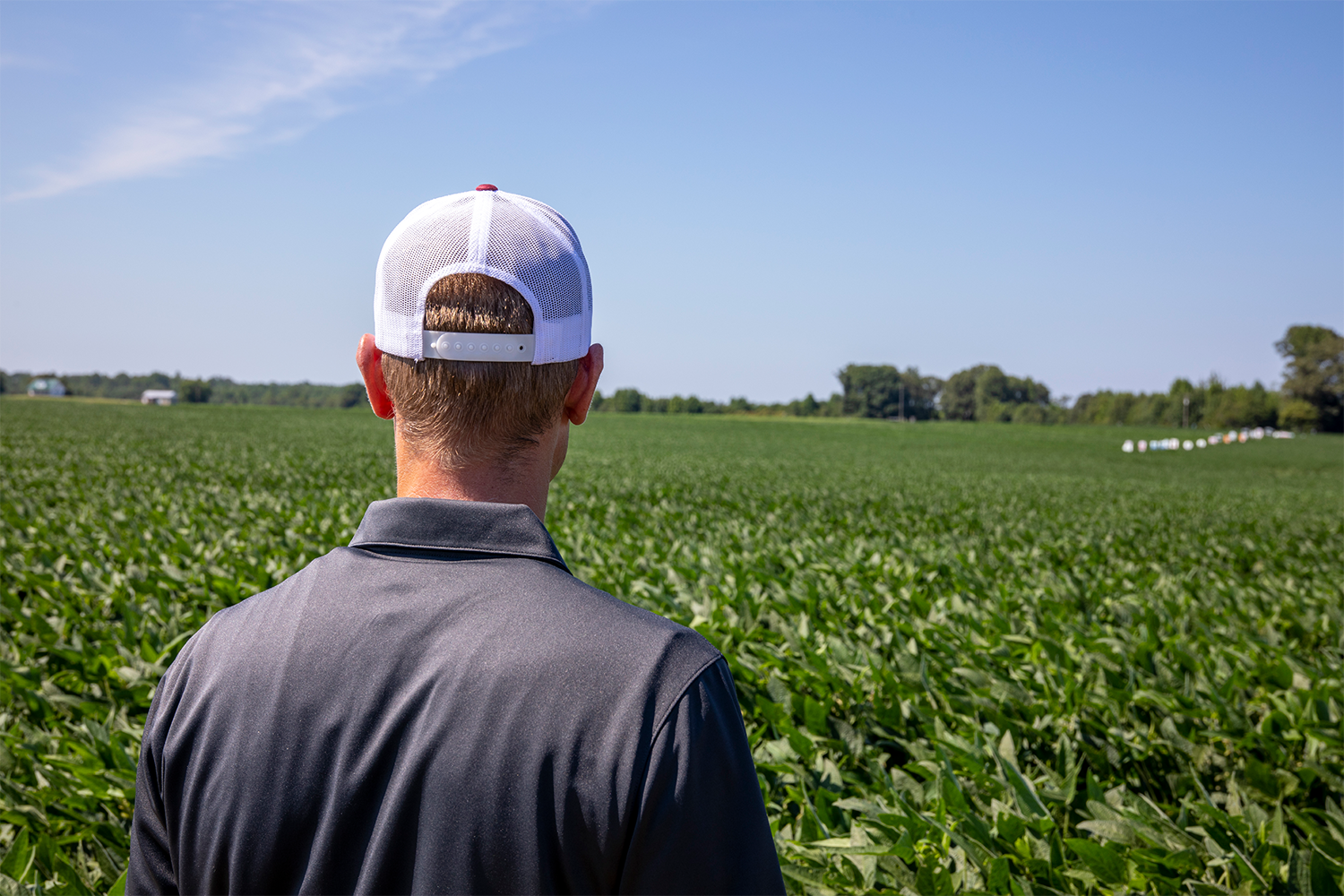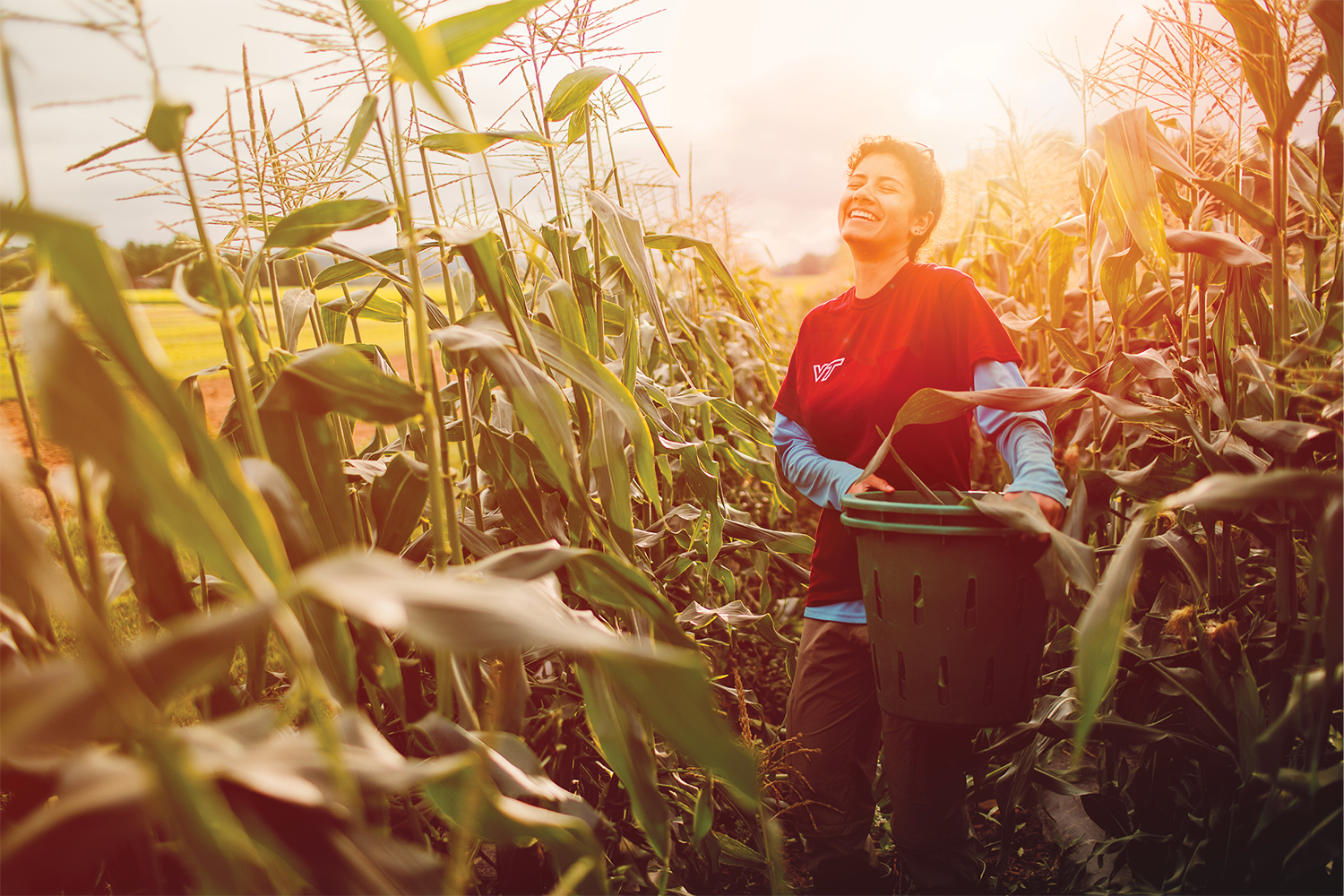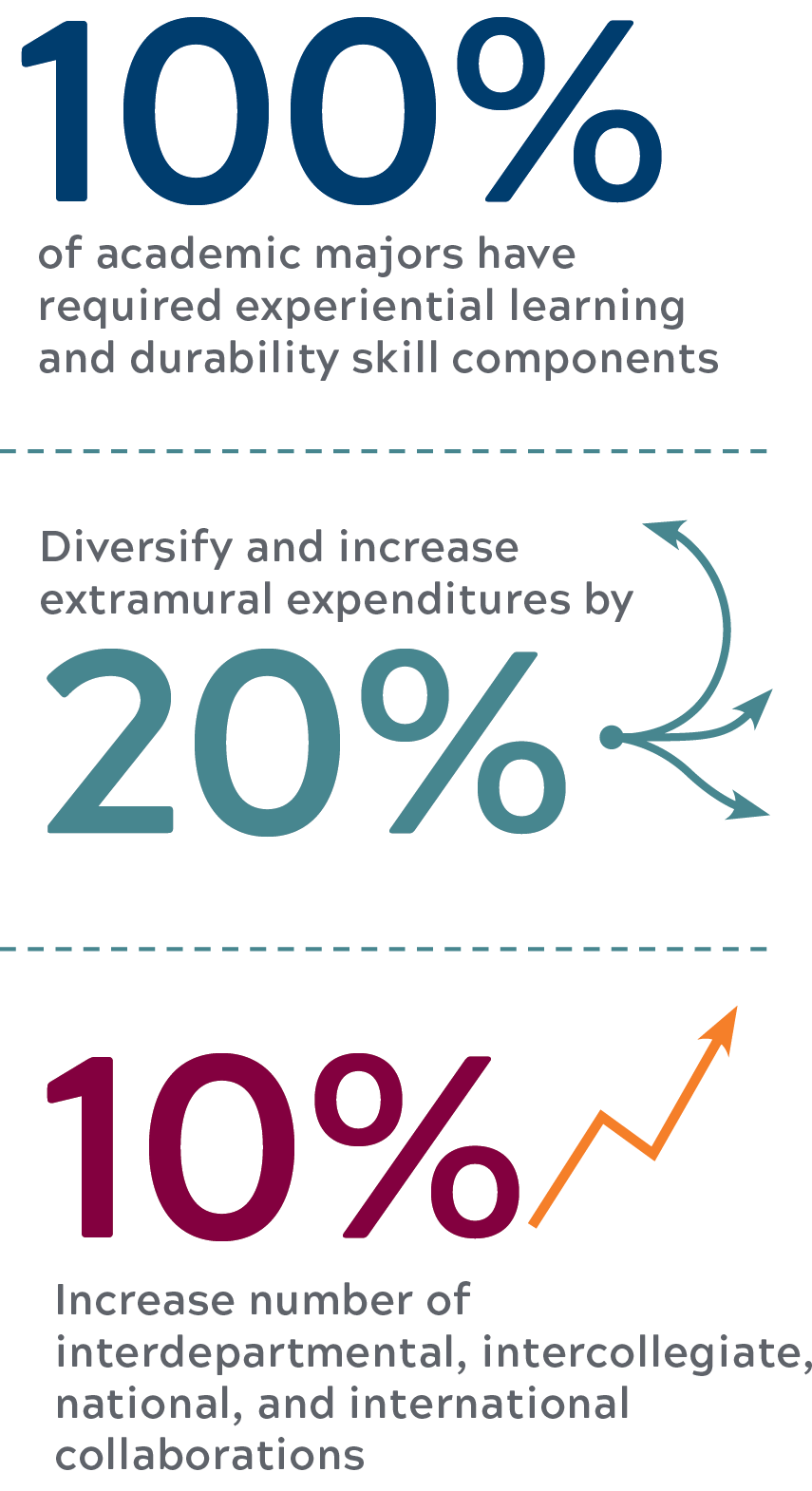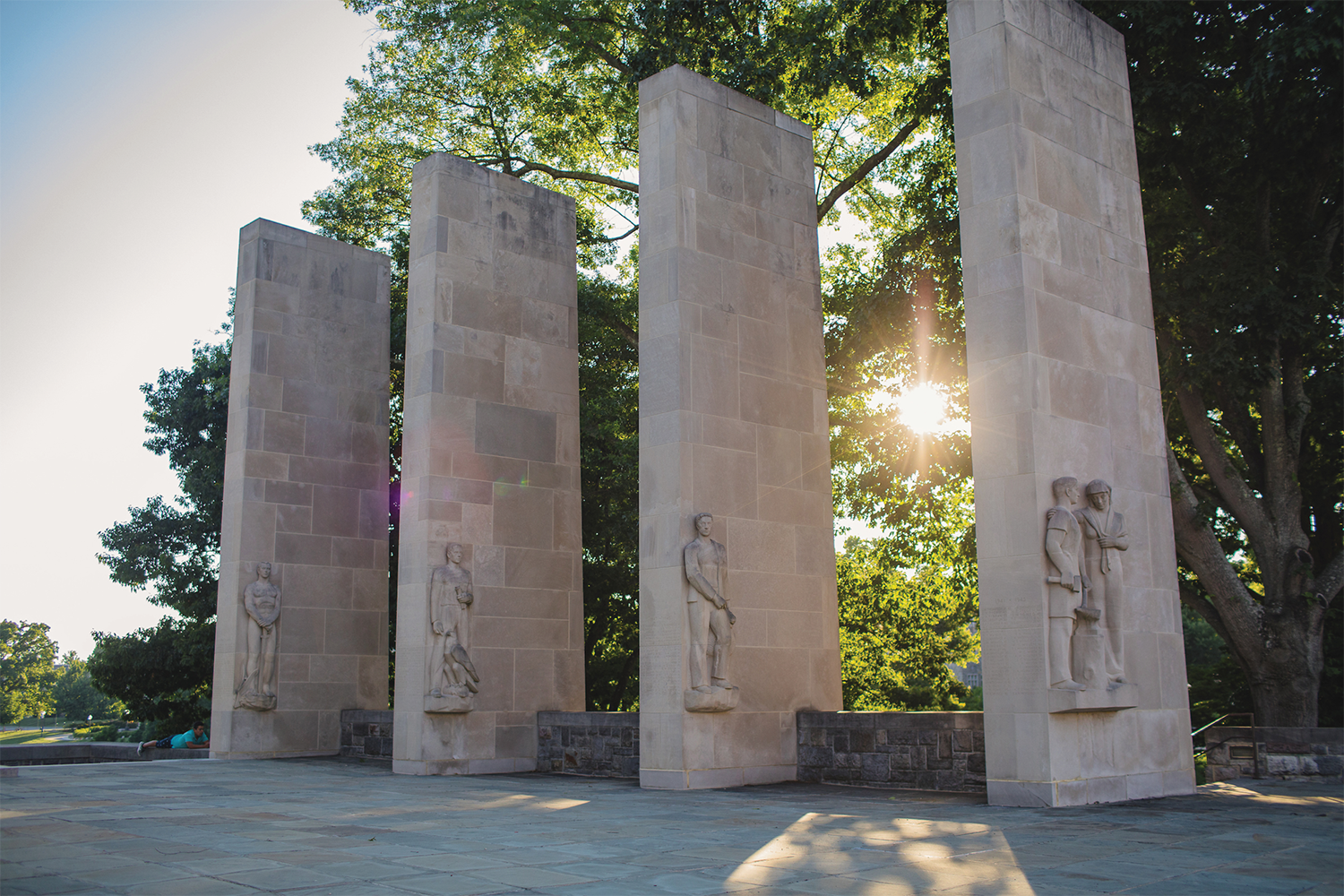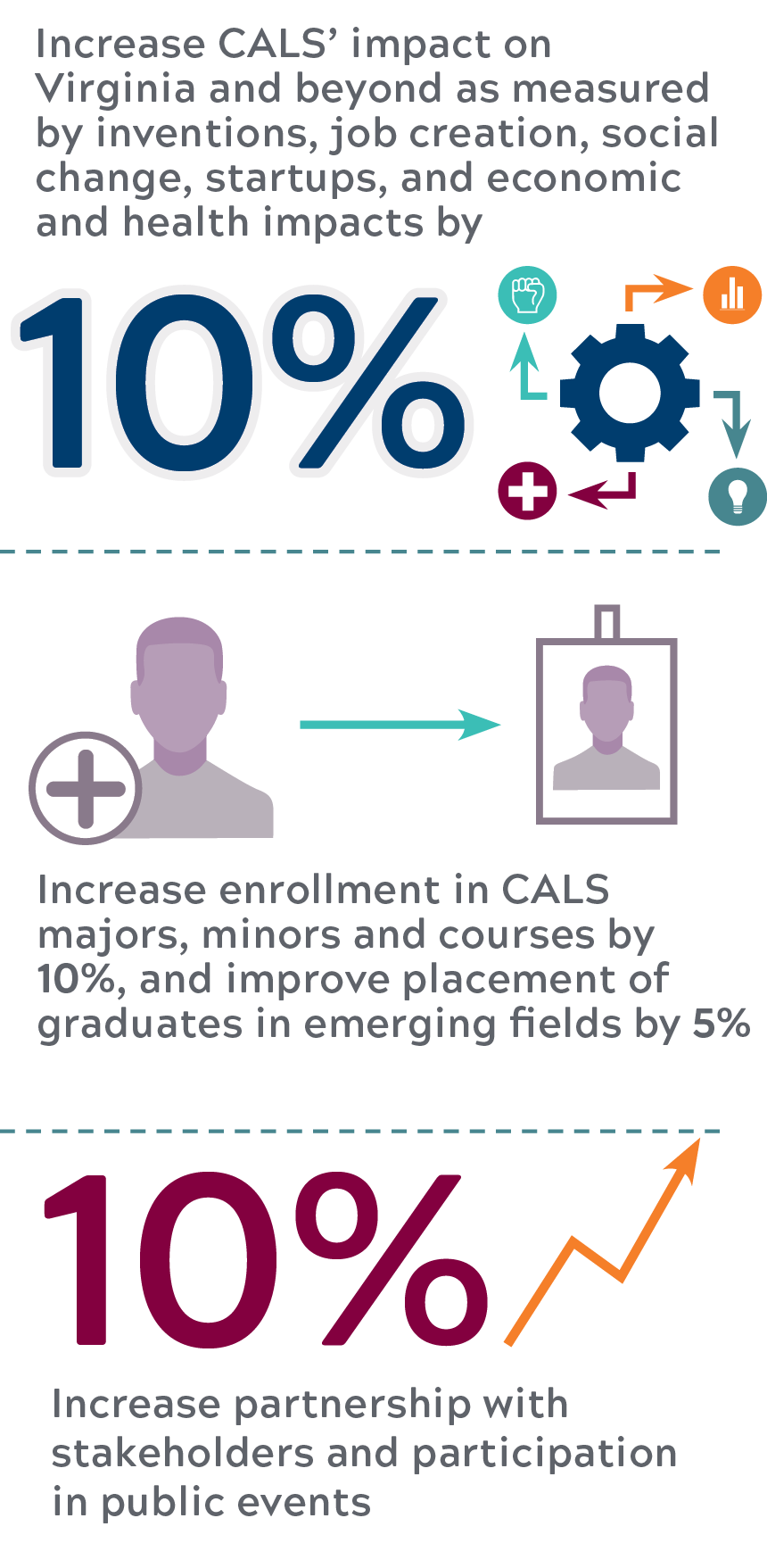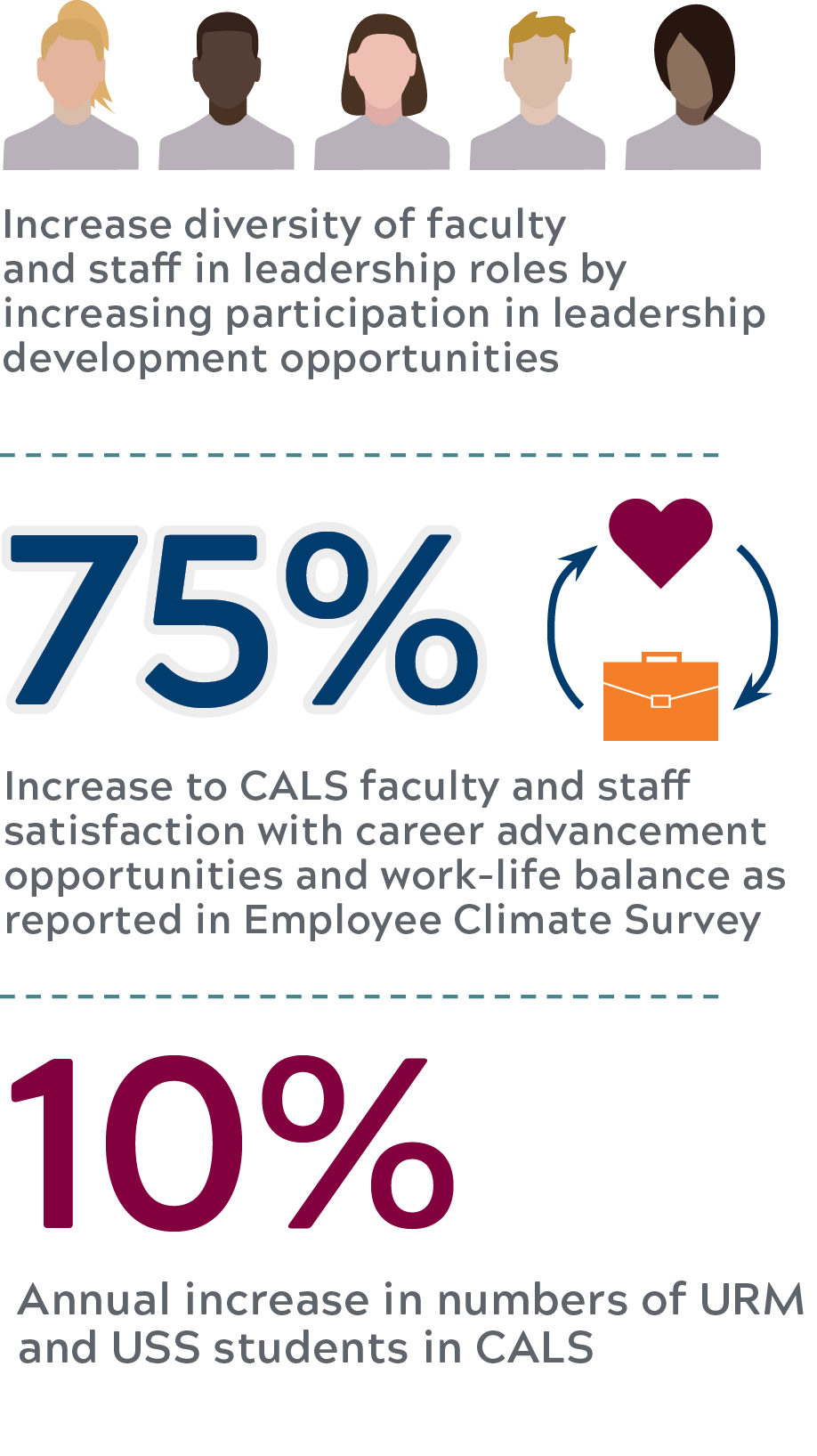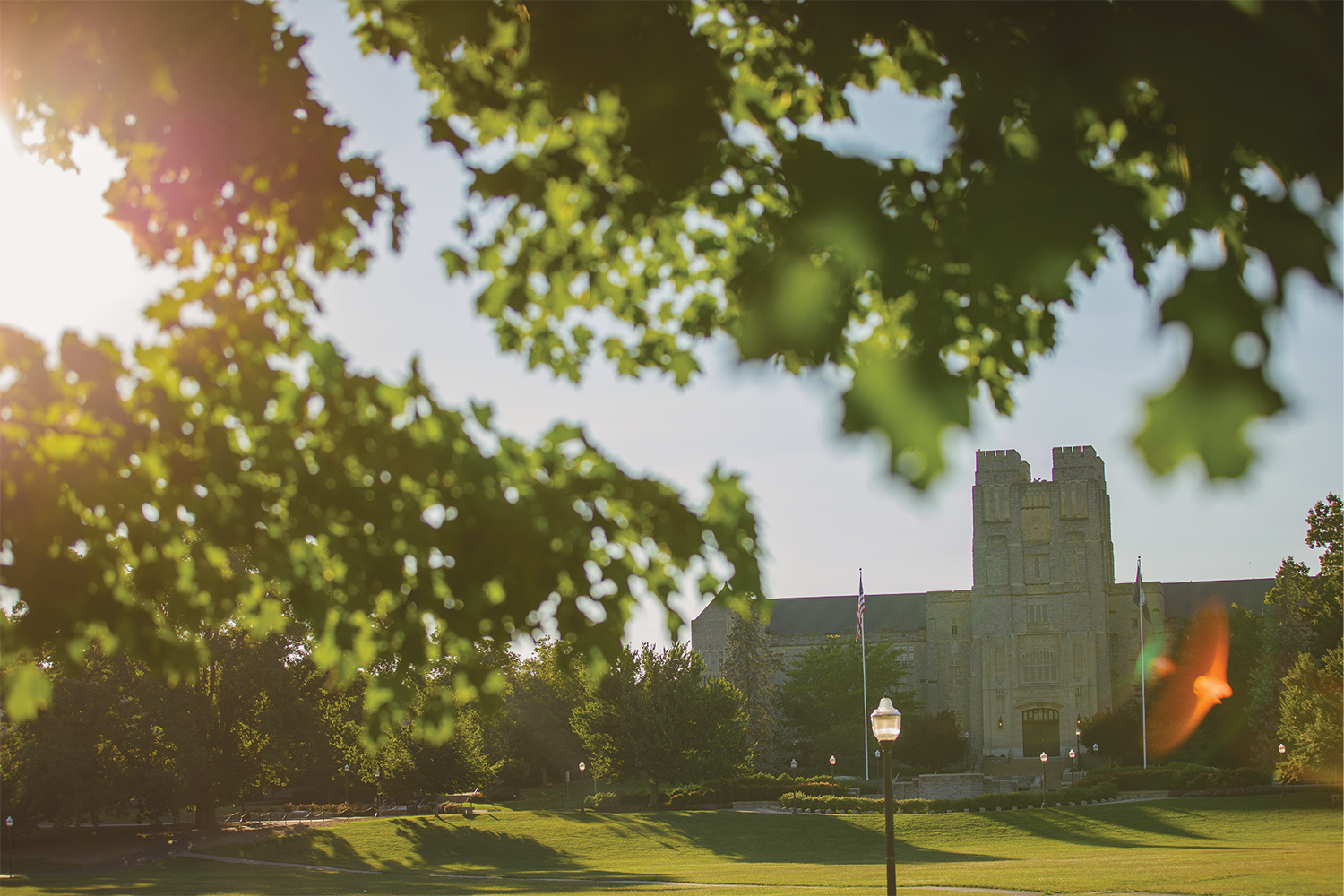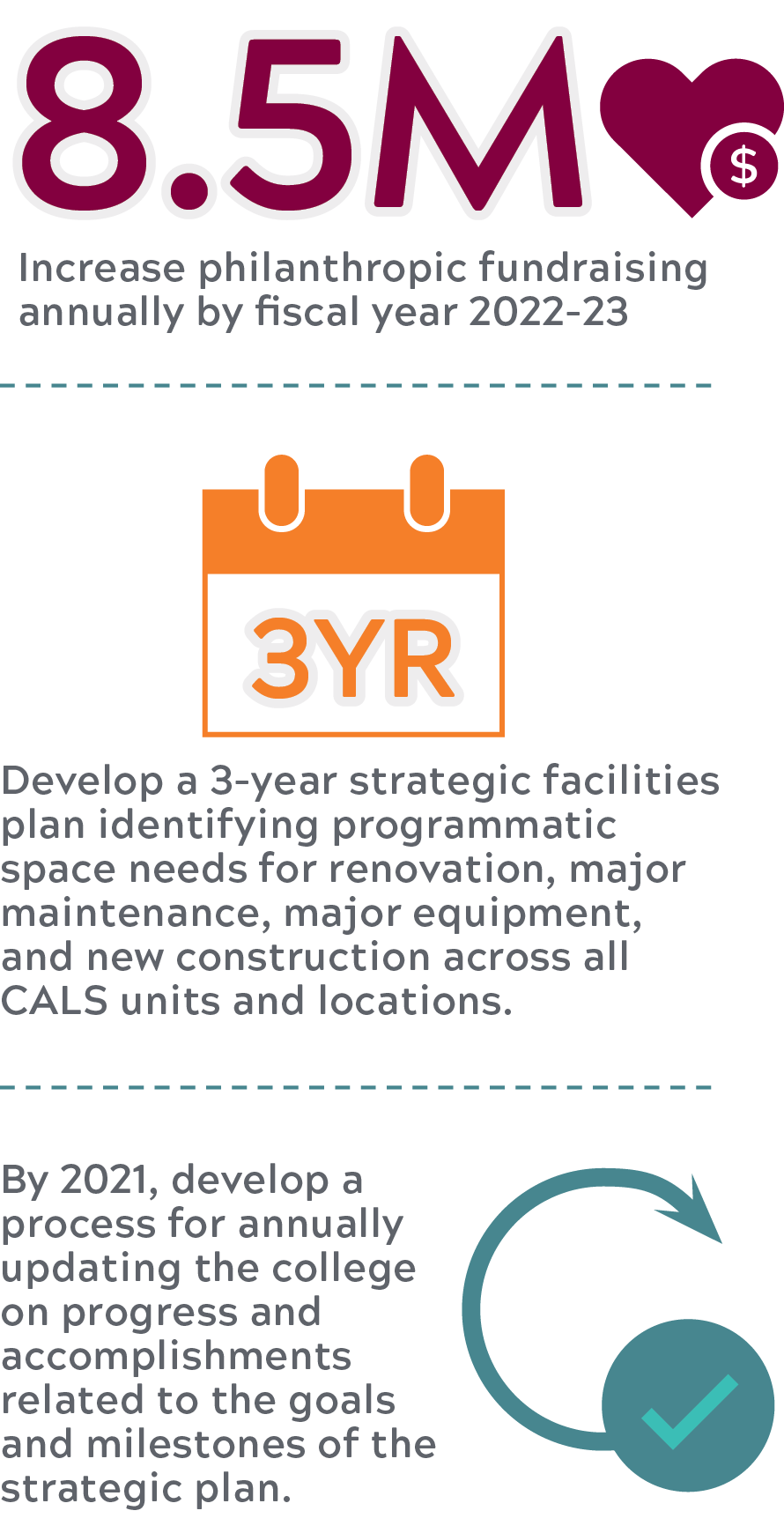CALS 2020
Strategic Plan
Vision
We address current and emerging issues in agriculture and life sciences by building on the land-grant commitment of developing leaders and creating and sharing knowledge through diverse, hands-on applications that ultimately help communities thrive.
Mission
The college creates, integrates, and shares knowledge to enhance:
Life sciences, food, and agricultural systems The economic prosperity and life quality of the greater community The stewardship and health of land, water, and air for future generations Student learning through diverse, hands-on, experiential opportunities
Values
The College of Agriculture and Life Sciences embraces the following core values:
Freedom of inquiry Mutual respect Lifelong learning A commitment to welcoming, inclusive, and diverse communities Ut Prosim (That I May Serve) Personal and institutional integrity A culture of continuous improvement and inclusive excellence Integrated scholarship across the land-grant missions Global engagement in teaching, research, and outreach Interdisciplinary collaboration
Land-grant mission
Land-grant mission
Introduction
Virginia Tech is home to one of the nation’s premier comprehensive agricultural and life sciences programs. Our premise in the College of Agriculture and Life Sciences is that a thriving college can help create thriving communities. A thriving college is one that includes: a diverse, innovative, and creative world-class faculty; talented and forward-looking staff and students; a diverse student body; state-of the-art facilities; and engaged stakeholders and alumni. Achieving these elements allows the college to solve current and emerging problems, to make positive impacts on people and their work and lives, and ultimately to create thriving communities around the world. This ambitious vision is aligned well with Virginia Tech’s commitment to Ut Prosim (That I May Serve) and the efforts to advance Virginia Tech’s Beyond Boundaries Initiative.
Beyond boundaries

Strategic planning process
Beyond Boundaries
The foundation for our strategic planning process started more than three years ago, beginning with consultations with internal stakeholders and external constituents. This process helped define our strengths as a college and laid the groundwork for how to convey our vision in the coming years. We further refined this vision in 2019, when CALS leadership and selected faculty members met for two days to define the areas in which our college has unique and differentiating strengths and where we can best focus our efforts to make a difference in the world. These exercises resulted in a message that encompasses both the breadth and depth of work in the college. It highlights the impact of what we do, and goes to the heart of our teaching, research, and outreach missions: CALS helps communities thrive.
Strategic priority 1
Advance excellence in research, teaching, and extension for the commonwealth and beyond
Aspirational vision:
The College of Agriculture and Life Sciences will be a global leader with world-class faculty and students by advancing its research, teaching, and extension missions as part of a comprehensive land-grant university.
Goals:
- Advance excellence in research and discovery
- Advance teaching and learning excellence
- Advance excellence in extension and outreach for the commonwealth and beyond

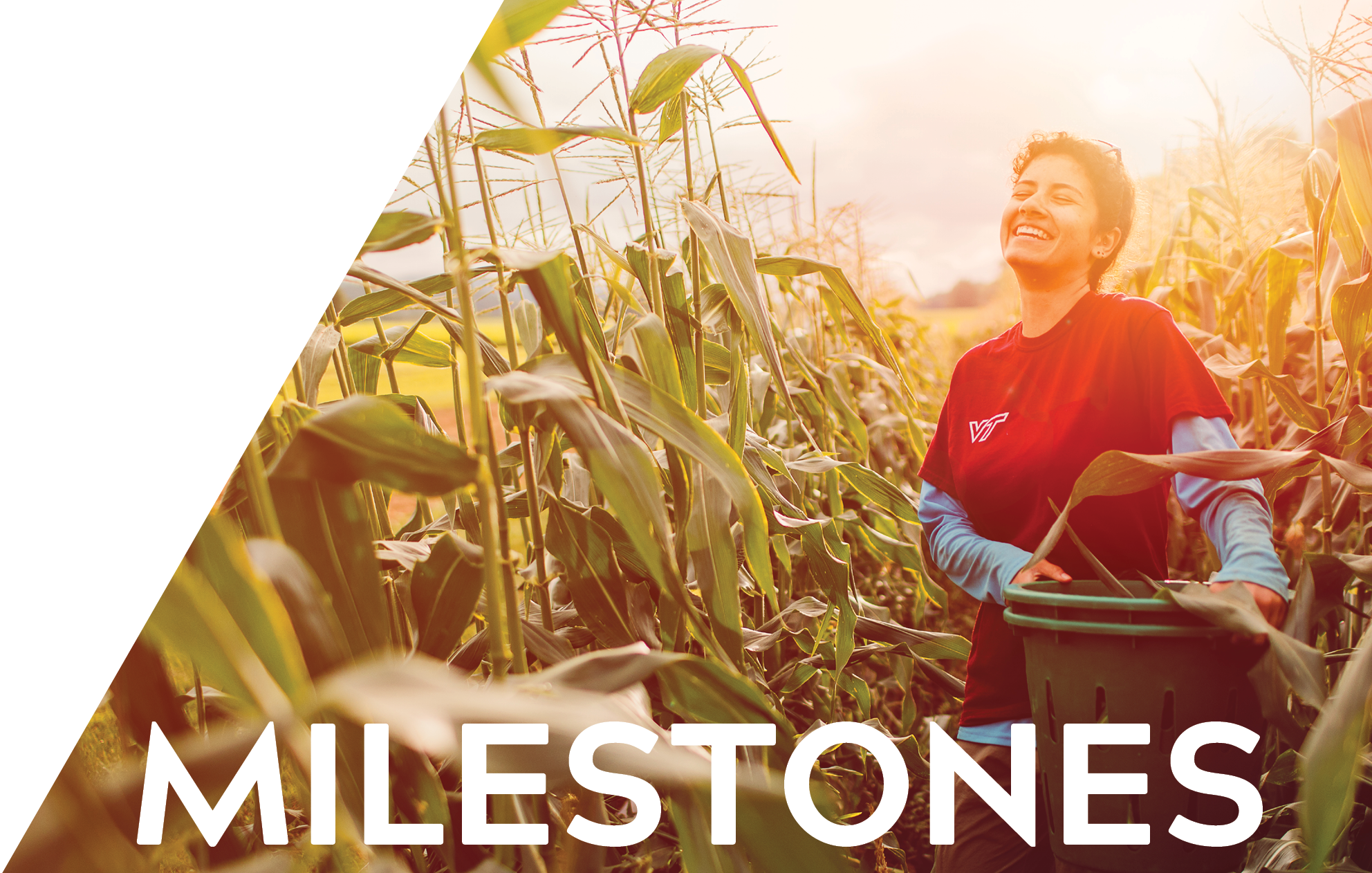
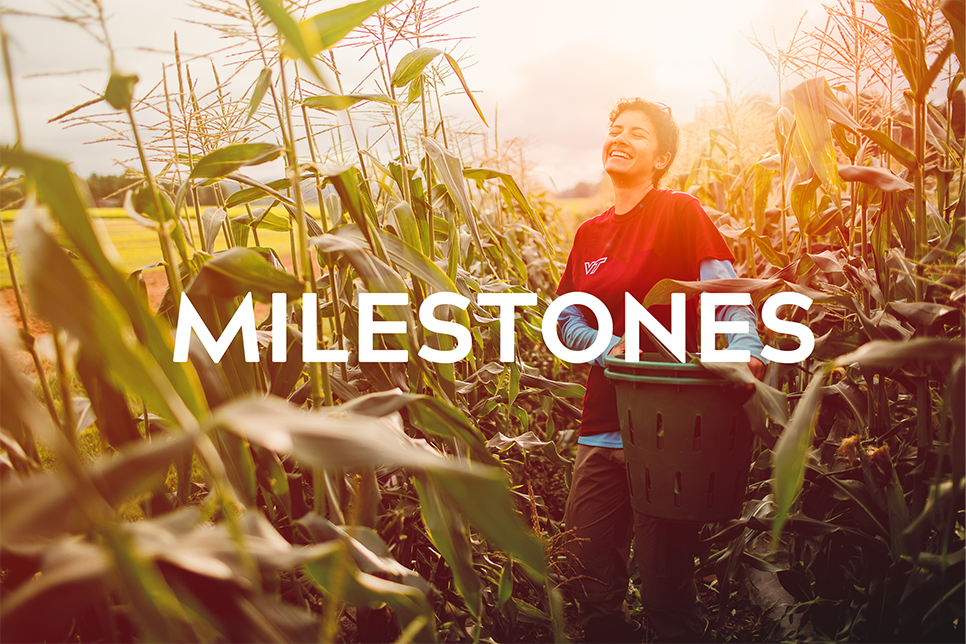
- Diversify and increase extramural expenditures by 20%.
- Increase number of interdepartmental, intercollegiate, national, and international collaborations by 10%.
- Ensure that 100% of academic majors have required experiential learning and durability skill components and increase undergraduate involvement in research, teaching and extension and graduate involvement in teaching and extension by 5% annually.
- Increase faculty participation in pedagogy and extension training by 5% annually.
- Broaden collaborations by building new and leveraging existing partnerships at multiple scales, from campus to global.
- Increase indicators of excellence across our missions, including nominations of faculty, staff, and students for awards, departments ranked among the top 10 of their peers, and comparative rankings of CALS with land-grant peers.
Strategic priority 2
Elevate the Ut Prosim (That I May Serve) Difference
Aspirational vision:
The College of Agriculture and Life Sciences is the foundational component of Virginia Tech’s Ut Prosim (That I May Serve) mission of service to humanity. CALS will build and support communities of discovery and learning for global citizens to engage with critical and emerging challenges.
Goals:
- Address critical challenges related to environment, health, economy, and food, to build diverse and inclusive communities
- Increase global impact and visibility of CALS
- Support lifelong engagement, learning, and opportunity for alumni and local communities

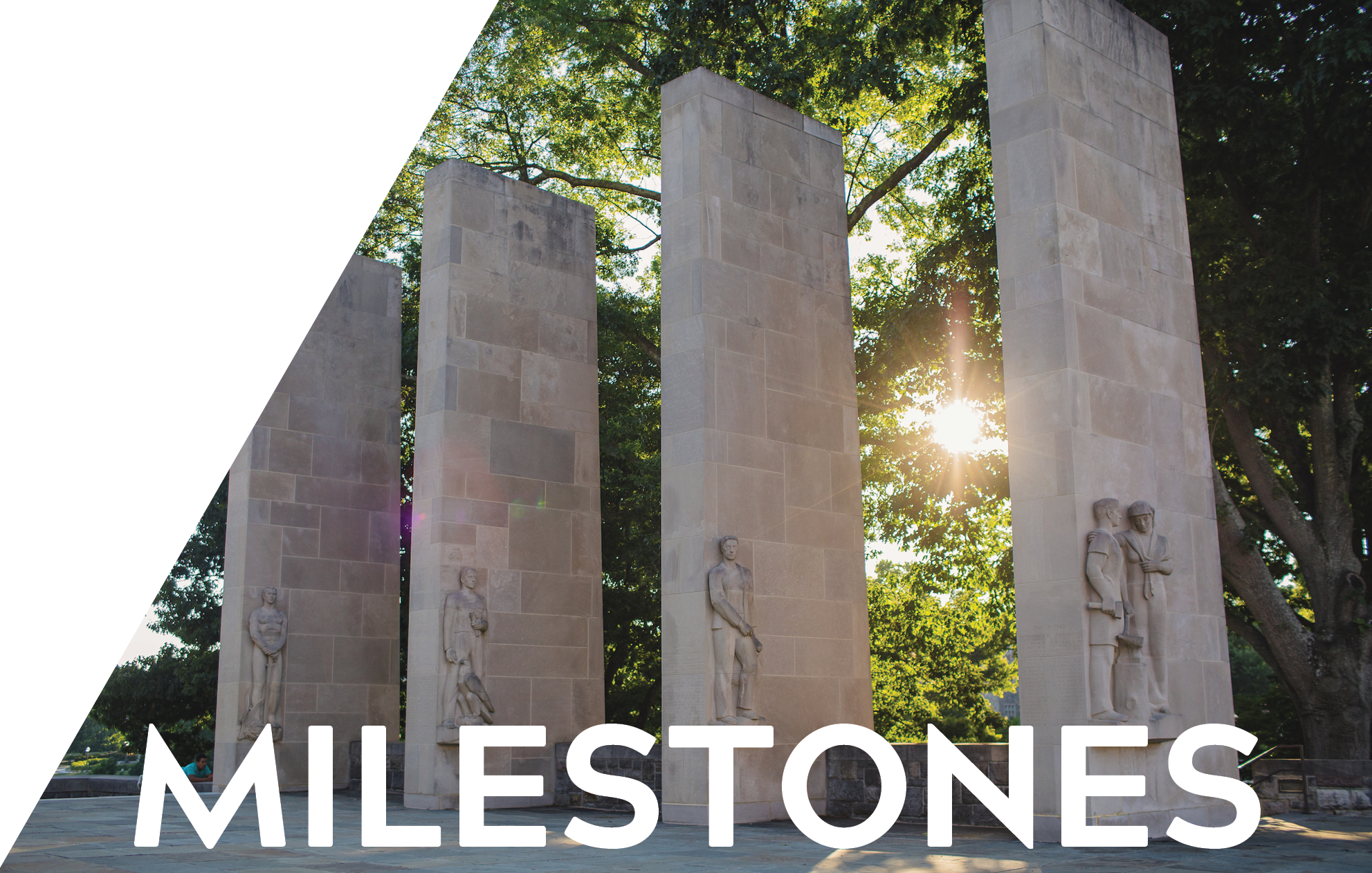

- Increase partnerships with stakeholders (e.g. government, industry, nonprofits) and participation in public events highlighting critical environment, health, economy, and food challenges by 10%.
- Enhance internal engagement and communication to raise awareness of CALS engagement in communities around the world.
- Continually update and enhance graduate and undergraduate degree programs, majors, minors and course offerings across the college to reflect current and emerging challenges.
- Increase enrollment in CALS majors, minors and courses by 10%, and improve placement of graduates in emerging fields by 5%.
- Increase external communication about CALS activities addressing critical environment, health, economy, and food challenges as measured by the number of scholarly publications, citations, and popular media stories by 15%.
- Increase CALS’ impact on Virginia and beyond as measured by inventions, job creation, social change, startups, and economic and health impacts by 10%.
- Increase on-site and virtual learning opportunities for alumni and community members at CALS, Agricultural Research and Extension Centers and Virginia Cooperative Extension locations throughout the Commonwealth by 10%.
Strategic priority 3
Be a Destination for Talent
Aspirational vision:
The College of Agriculture and Life Sciences will be a force for positive change by attracting and retaining innovative, diverse, and dynamic faculty, staff, and students. Alumni, local, and global communities will recognize Virginia Tech as a lifelong learning destination. CALS will invest, empower, support, and value a workforce that will champion our vision for the future.
Goals:
- Attract, retain, and develop the talents of diverse faculty and staff in research, teaching, and extension
- Align salaries with land-grant peers
- Attract, retain, and ensure degree completion of students
- Increase representational diversity and cultural awareness in academics, research and extension



- Increase hiring and retention of diverse faculty and staff: URM faculty (to 15%), URM staff (to 20%), and achieve 50% females in all faculty ranks and 40% tenured and tenure-track female faculty
- Increase diversity of faculty and staff in leadership roles by increasing participation in leadership development opportunities.
- Increase CALS faculty and staff satisfaction with career advancement opportunities and work-life balance to at least 75% as reported in Employee Climate Survey.
- Achieve progress in competitive administrative and professional faculty and staff salaries towards the 50th percentile of relevant market range.
- Increase numbers of URM and USS students in CALS by 10% annually.
- For first-year undergraduate students entering CALS, increase 4-year graduation rate within CALS to 52.2% and within Virginia Tech to 74.2%.
- Eliminate graduation rate gap between URM/USS and non-URM/USS students.
Strategic priority 4
Ensure Institutional Excellence
Aspirational vision:
The College of Agriculture and Life Sciences will, through continuous strategic planning with intentional stakeholder involvement, create opportunities to solicit and explore innovative ideas, inform resource allocation, and engage the college’s system of shared governance. CALS will also optimize efficiency, effectiveness of personnel, fiscal resources and processes in support of strategic goals across the statewide campus and global community.
Goals:
- Continually enhance the physical and technological resources and human capital of the statewide and global campus to nurture robust, inter-disciplinary research, extension and instructional programs
- Develop and foster mutually beneficial relationships with internal and external stakeholders.
- Develop sustainable financial models necessary for meeting the human and physical aspirations of the college
- Develop and launch an adaptive inclusive process for continuous strategic planning

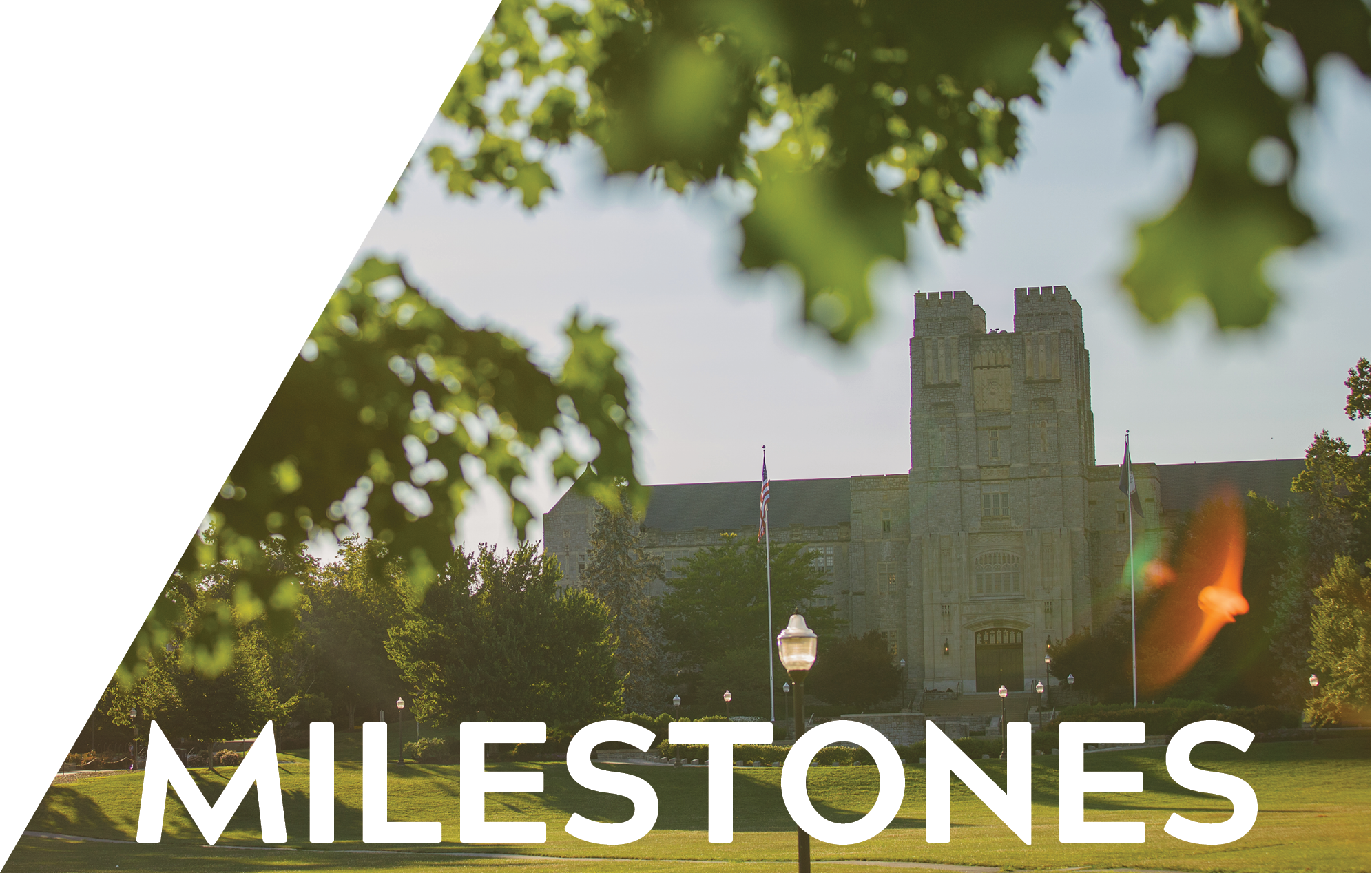
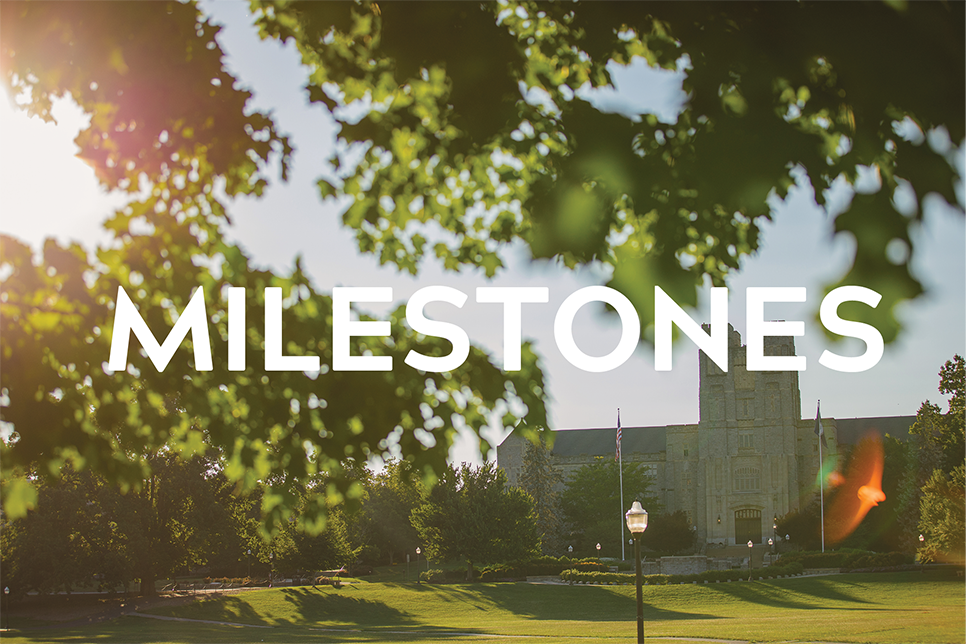
- Increase alumni giving to 19% by fiscal year 2021-22.
- Increase philanthropic fundraising to $8.5M annually by fiscal year 2022-23.
- Develop and implement (with annual evaluation) a sustainable financial model and strategy for regular replacement and upgrades of computer and connectivity hardware.
- Develop a 3-year strategic facilities plan identifying programmatic space needs for renovation, major maintenance, major equipment, and new construction across all CALS units and locations.
- By 2022, ensure that existing and new programs empower faculty, staff, and students to apply for modest grants to try new ideas and develop innovative approaches and creative solutions, to advance excellence in college.
- By 2021, develop a process for annually updating the college on progress and accomplishments related to the goals and milestones of the strategic plan.
Appendix
Alan Grant,
Dean
Tom Thompson,
Associate Dean, Strategic Planning Coordinator
STEERING COMMITTEE
Zeke Barlow
Matt Hulver
Lonnie Johnson
Ed Jones*
Stephen Kleiber
Tim Kring
Vernon Meacham
Saied Mostaghimi*
Tracy Rutherford
Susan Sumner*
Chevon Thorpe
Tony Wolf
*Working group member
STRATEGIC PRIORITY 1:
Advance Excellence In Research, Teaching, And Extension For The Commonwealth And Beyond
Megan O’Rourke,
School of Plant and Environmental Sciences (Working Group Chair)
Saied Mostaghimi,
Associate Dean (Liaison To Steering Committee)
Patricia Donovan,
School of Plant and Environmental Sciences
Alan Ealy,
Animal and Poultry Sciences
Zach Easton,
Biological Systems Engineering
Haibo Huang,
Food Science and Technology
Kiho Lee,
Animal and Poultry Sciences
Janet Rinehart,
Human Nutrition, Foods and Exercise
Jayesh Samtani,
Hampton Roads AREC
Daniel Slade,
Biochemistry
Christy Teets,
Dairy Science
Zhijian (Jake) Tu,
Biochemistry
Kang Xia,
School of Plant and Environmental Sciences
STRATEGIC PRIORITY 2:
Elevate The Ut Prosim Difference
Olga Isengildina Massa,
Agricultural and Applied Economics (Working Group Chair)
Susan Sumner,
Associate Dean (Liaison To Steering Committee)
Rebecca Cockrum,
Dairy Science
Janet Donahue,
Biochemistry
Tim Kring,
Entomology
Tom Martin,
Agricultural Technology
John McDowell,
School of Plant and Environmental Sciences
Kim Niewolny,
Agricultural, Leadership, and Community Education
Mark Reiter,
Eastern Shore AREC
Janet Spencer,
VCE Southeast District
Jonathan van Senten,
Virginia Seafood AREC
Katie White,
Agricultural and Applied Economics
Molly Wilson,
Academic Programs
STRATEGIC PRIORITY 3:
Be A Destination For Talent
Rob Williams,
Food Science and Technology, (Working Group Chair)
Matt Hulver,
Assistant Dean (Liaison To Steering Committee)
Jonathan Auguste,
Entomology
Stephanie Brown,
Human Resources
Helene Doughty,
Eastern Shore AREC
Mark Estienne,
Tidewater AREC
Erin Ling,
Biological Systems Engineering
Diana McHenry,
Alson H. Smith, Jr. AREC
Kathryn Payne,
Southern Piedmont AREC
Tracy Rutherford,
Agricultural, Leadership, and Community Education
Hannah Scherer,
Agricultural, Leadership, and Community Education
Michael Schwarz,
Virginia Seafood AREC
John Thompson,
VCE Northern District
STRATEGIC PRIORITY 4:
Ensure Institutional Excellence
Neal Vines,
CALS IT (Working Group Chair)
Ed Jones,
Associate Dean (Liaison To Steering Committee)
Susan Duncan,
Virginia Agricultural Experiment Station
Ben Grove,
CALS Global and VCE
Stephanie Hedrick,
Agricultural and Applied Economics
Patrick Hilt,
Facilities
Joseph Oakes,
Eastern Virginia AREC
Scott Salom,
Entomology
Elena Serrano,
Human Nutrition, Foods and Exercise
Sherif Sherif,
Alson H. Smith, Jr. AREC
Crystal Wall,
School of Plant and Environmental Sciences
Kim Waterman,
Food Science and Technology
Tony Wolf,
Alson H. Smith, Jr. AREC



